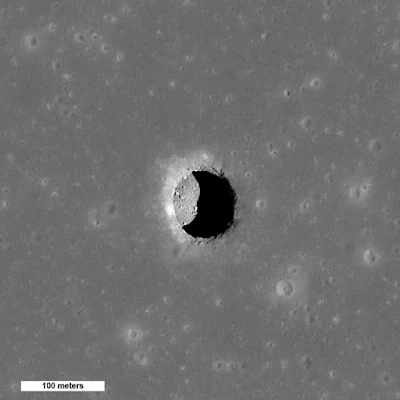Σήραγγες
λάβας στον Άρη, οι οποίες ίσως φιλοξενούν κάποια μορφή ζωής, ζητά από τη NASA
να εξετάσει η αστροβιολόγος Τσάριτι Φίλιπς-Λάντερ. Mars, at one time
in its past, was wet and warm, and may have hosted life. Over time, it was
stripped of its atmosphere and its water, and became frigid. But if there was
life there, it may have had time to "migrate" to the only remaining
niches where it could survive. On
Mars, that might mean lava tubes. Credit: NASA
Σήραγγες
λάβας στον Άρη, οι οποίες ίσως φιλοξενούν κάποια μορφή ζωής, ζητά από τη NASA
να εξετάσει η αστροβιολόγος Τσάριτι Φίλιπς-Λάντερ.
The Kazamura Cave
is the longest lava tube on Earth. It features the tell-tale arched ceiling of
lava tubes, and the floor was the crust of a former lava lake that collapsed
inward as the lake drained. Credit: Dave Bunnell / Under Earth Images – Own
work, CC BY-SA 4.0, https://commons.wikimedia.org/w/index.php?curid=48891612
The collapsed
sklyight on a lava tube in the Moon’s Marius Hills region, as imaged by NASA’s
Lunar Reconnaissance Orbiter. Credit: ASA/GSFC
Η
Αμερικανίδα Τσάριτι Φίλιπς-Λάντερ από το Southwest Research Institute στο Τέξας
θέλει η NASA να εξερευνήσει σήραγγες λάβας στον Άρη, καθώς η αστροβιολόγος και
η ομάδα της υποπτεύονται ότι μπορεί εκεί να εντοπιστεί εξωγήινη ζωή.
An image of a
partially collapsed lava tube near the lunar equator, captured by India’s
Chandrayaan-1 lunar orbiter. Image
Credit: Indian Space Applications Centre
An image of a lava
tube on Mars’ Alba Mons, from NASA’s Viking Orbiter. Credit: NASA
Ειδικότερα,
η σύνθεση της ατμόσφαιρας του πλανήτη, οι ακραίες θερμοκρασίες του που μπορούν
να φτάσουν έως τους -153 βαθμούς Κελσίου και η κοσμική ακτινοβολία καθιστούν
την επιφάνεια του Άρη αφιλόξενη, οπότε αν κάποιος ψάχνει για σημάδια ζωής και
εξωγήινους πολιτισμούς τότε ίσως πρέπει να εστιάσει κάτω από τη βραχώδη
επιφάνειά του.
An illustration of
a longitudinal cross-section of a Martian lava pit. These are potentially
hazardous environments, better explored by robot than by humans. Credit:
Melissausburn – Own work, CC BY-SA 3.0, https://commons.wikimedia.org/w/index.php?curid=31385296
Η
Φίλιπς-Λάντερ, άλλωστε, επισημαίνει πως: «Εάν υπάρχει ζωή εκεί, πιθανότατα θα
διατηρηθεί καλύτερα κάτω από την επιφάνεια».
Four panels from a
video presentation on the Moon Diver concept. From left to right: Rover is
deployed from the lander, rover rappels down the hole, with Earth in the
background, the rover hanging free as it’s lowered to the floor. Though the
concept was developed to explore the Moon, something similar would likely work
on Mars. Credit: KISSCaltech
Η
αστροβιολόγος και η ομάδα της πιστεύουν ότι η NASA πρέπει να στείλει ένα ρομπότ
για να μελετήσει τα σπήλαια στον Άρη στο εγγύς μέλλον, ενώ οι ερευνητές
σημειώνουν ότι η τεχνολογική πρόοδος θα καταστήσει δυνατή μια τέτοια αποστολή
μέσα στην επόμενη δεκαετία.
Many of the cave
openings and lava tube skylights the USGS has identified on Mars is in the
post-volcanic Tharsis Region. In this image, each red dot is a candidate
entrance. Image Credit:
USGS/Mars Global Cave Candidate Catalog.
The Moon and Mars
will probably be the first places in the Solar System that humanity will try to
live after leaving the safety and security of Earth. But those worlds are still
incredibly harsh environments, with no protection from radiation, little to no
atmosphere, and extreme temperatures. Living on those worlds is going to be
hard, it’s going to be dangerous. Fortunately, there are a few pockets on those
worlds that’ll make it a tiny little bit easier to get a foothold in the Solar
System: lava tubes.
Υπογραμμίζεται,
ακόμα, ότι ο Πασκάλ Λεμ, ερευνητής σε κέντρο της NASA στην Καλιφόρνια, ανέφερε
ότι «στον Άρη και σε άλλα μέρη, οι σήραγγες λάβας έχουν τη δυνατότητα να κάνουν
τη διαφορά μεταξύ ζωής και θανάτου».
Πηγές: Sid
Perkins. Core Concept: Lava tubes may be havens for ancient alien life and
future human explorers, Proceedings of the National Academy of Sciences (2020). DOI: 10.1073/pnas.2012176117 - https://phys.org/news/2020-07-lava-tubes-exploration-priority-worlds.html - https://www.tovima.gr/2020/07/19/science/yparksi-zois-ston-ari-ypooteyontai-epistimones-zitoun-apo-ti-nasa-na-eksetasei-siragges-lavas/








